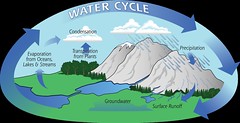AP Biology: Chapter 55 (ecosystems) Flashcards
Terms : Hide Images [1]
| 9818487853 | Ecosystem | The sum of all the organisms living in a given area and the abiotic factors with which they interact (varying sizes of areas) | 0 | |
| 9818487854 | Energy flow in ecosystems | Enters as sunlight, goes to autotrophs, dispersed among heterotrophs | 1 | |
| 9818487855 | Transform | What do cells do to matter and energy? | 2 | |
| 9818487856 | Law of Conservation of Mass | Matter cannot be created or destroyed, only transformed | 3 | |
| 9818487857 | Primary producer | Trophic level that supports all others (Autotroph) | 4 | |
| 9818487858 | Primary consumer | Herbivore that eats the primary producers (Heterotroph) | 5 | |
| 9818487859 | Secondary consumer | Carnivores that eat herbivores | 6 | |
| 9818487860 | Tertiary consumer | Carnivores that eat other carnivores | 7 | |
| 9818487861 | Detrivores | Get nutrients from nonliving organic material (dead organisms, fallen leaves) | 8 | |
| 9818487862 | Primary production of an ecosystem | The amount of light energy converted to chemical energy by autotrophs in the form of organic compounds | 9 | |
| 9818487863 | Gross Primary Production (GPP) | Total primary production in an ecosystem-- the amount of energy from light converted the chemical energy or organic molecules per unit time | 10 | |
| 9818487864 | Net Primary Production (NPP) | Gross primary production minus the energy used by the primary producers for their "autotrophic respiration" (Usually half of GPP on average) (Expressed as energy per unit area per unit time) |  | 11 |
| 9818487865 | Limiting nutrient | The element that must be added for production to increase (Usually Nitrogen or Phosphorous--sometimes iron) | 12 | |
| 9818487866 | Secondary Production | The amount of chemical energy in consumers' food that is converted to their own new biomass during a given period | 13 | |
| 9818487867 | Energy production efficiency | Percentage of energy stored in assimilated food that is not used for respiration | 14 | |
| 9818487868 | Assimilation of primary production | Consists of total energy taken in used for growth, reproduction, and respiration (not including losses in feces) | 15 | |
| 9818487869 | Trophic efficiency | Percentage of production transferred from one trophic level to the next (generally only about 10% and range from 5-20% (90% of the energy in one trophic level is typically not transferred to the next) | 16 | |
| 9818487870 | Pyramid of Net production | Demonstrates the loss of energy with each transfer in a food chain, trophic levels are arranged in tiers where the width of each trophic level is proportional to the net production in Joules | 17 | |
| 9818487871 | Biomass pyramid | Represents ecological consequences of low trophic efficiencies, each tier represents the standing crop (total dry mass of all oragnisms) in one trophic level | 18 | |
| 9818487872 | Carbon cycle | CO2 -> Photosythesis -> Cellular respiration |  | 19 |
| 9818487873 | Nitrogen cycle | N2 -> N fixation -> Organisms -> Denitrification |  | 20 |
| 9818487874 | The water cycle | Evaporation, Condensation, Precipitation |  | 21 |
| 9818487875 | Phosphorous cycle | Weathering of rocks adds phosphorous to soil, some leaches into groundwater and surface water and may eventually reach the sea, producers take in phosphates, consumers eat producers, phosphate is returned to soil or water (Phosphorous never goes into the atmosphere) |  | 22 |
